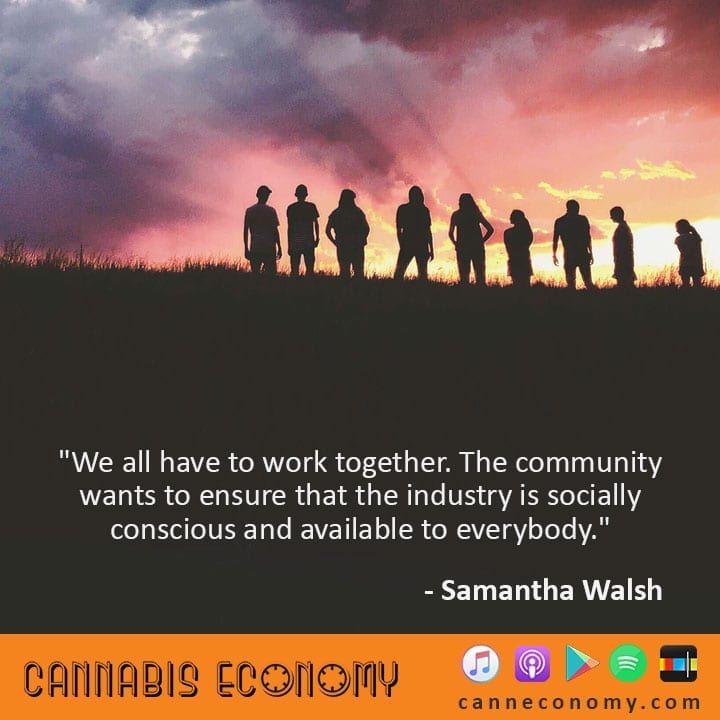
Ep. 387: Hemp Spotlight, Wendy Mosher and Samantha Walsh
December 12, 2018Samantha Walsh and Wendy Mosher join us and share the importance of all the moving parts in cannabis product manufacturing and agriculture: “It’s not in the scale of processing. We need all these pieces to come together and we’re getting there, but being able to process, ship it across state lines and get it approved in animal feed, all of those pieces need to come together and they’re so close.”
Transcript:
Seth Adler: Hemp Spotlight Three, welcome to Cannabis Economy. I'm your host Seth Adler, download episodes on canneconomy.com. Wendy Mosher and then Samantha Walsh join us. First a word from MedMen and then Wendy Mosher and Samantha Walsh.
Speaker 2: MedMen continues to expand its footprint on the cannabis landscape, opening new stores in Los Angeles, Las Vegas, and the iconic Fifth Avenue in Manhattan. They've also opened a 45,000 foot high tech cannabis cultivation and manufacturing facility in Nevada. The company has reached a $1 billion evaluation, making it the country's first cannabis unicorn, and it's just the beginning. Learn how MedMen is building the future of cannabis today at medmen.com.
Wendy Mosher: My name is Wendy Mosher and I'm the CEO of New West Genetics.
Seth Adler: What could that possibly be?
Wendy Mosher: New West Genetics could be, it could be many things, but what it is is a company founded by two scientists and myself with the intention of improving the sustainability in the cannabis industry by creating large scale varieties that can be cultivated from seed mechanically.
Seth Adler: Okay. Keep going.
Wendy Mosher: That make sense?
Seth Adler: No.
Wendy Mosher: Okay. Let me make it more specific.
Seth Adler: Please.
Wendy Mosher: So for instance, our first product is a very stable seed called Rely that is an industrial hemp cultivar or variety which you can put in the ground with a planting drill. You can plant tens of thousands of acres of it within, a few days and then at the end of the season you can harvest it with a combine.
Seth Adler: Okay. So I could harvest it with a combine and then coming out of that harvest would be what?
Wendy Mosher: Grain. So this is a grain cultivar, so you would harvest the green and then that green goes into a variety of food products. So you could press it for the oil, you can haul it to make protein powder, you can do a variety of things.
Seth Adler: And it's industrial hemp so this is under .3 of THC.
Wendy Mosher: Correct. So that's part of our specialty is that we can stabilize those profiles within the seed. On the market right now you can get a lot of clones and they do have ... The clonal market right now is the best for getting high contents of cannabinoids until we're finished breeding, which we're getting there, but-.
Seth Adler: Well, what do you mean? Let's just take that tangent.
Wendy Mosher: Okay, we're going on the tangent.
Seth Adler: Let's do it and then we'll come back.
Wendy Mosher: Okay. So our intention of course is to serve multiple markets with our varieties. So we have, for instance, of course a high CBD variety that we are narrowing and working on, we gain about a percent to a percent and a half cannabinoid content each breeding season that we have. So we have things in the greenhouse at 7$ that are stabilized below .3 so that's kind of a value people don't value as much.
Seth Adler: So 7% CBD.
Wendy Mosher: Correct.
Seth Adler: And below .3 THC.
Wendy Mosher: Correct, stably. So it's predictable and it will get entered into certified seed trials.
Seth Adler: Why do people not value that?
Wendy Mosher: One piece, they don't value as much as the below the .3 because the clonal stuff, there's some work arounds. So while there are a number of them and we've tested a number, are not stable below .3 all the way to harvest, the work around is that people are, as the flower matures, they're testing every week then every day so they can catch it before it goes over the .3.
Seth Adler: And then that's how product gets out into the marketplace that we don't need to have out in the marketplace.
Wendy Mosher: Some people are really good at catching it before it goes below .3 but that's added cost and it's added risk for a number of farmers. They're coming from more traditional production that they don't want.
Seth Adler: Certainly. So how are you establishing the stability then?
Wendy Mosher: That's just a matter of doing very elite selecting. So every season we test-, we do thousands of analytics samples. So genetics is a numbers game; the more you test, the more you can find it's a highly variant species and we've induced a lot of variation so it's not hard to find that profile, what is challenging is-.
Seth Adler: Is to keep at that profile.
Wendy Mosher: Is to keep it that profile, so you need to understand the genetics of the male and the female.
Read the full transcript:
Become a member to access to webinars, quarterly reports, contributor columns, shows, excerpts, and complete podcast transcripts
